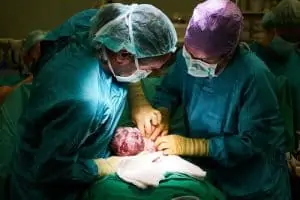As I’ve discussed endlessly, both my daughters were born by c-section. The first was an emergency c-section while the second one was planned out (you can read more about all that here). But I don’t think I’ve told you all yet that I was born via c-section. My big brother was too.
Back then, it was a much riskier procedure than it is today. And yes, while there are risks with c-sections, they are much more routine than when I was born. My dad used to tell me that c-section babies were smarter. I always thought so. After all, I was on the honor roll, as was my brother.
But was that true? Well, I’m no dummy, and neither is my c-section daughters. In fact, both of them are astoundingly bright. I’ll get into the science behind all this shortly, but you’re going to be surprised by the differences between c-section babies and babies born naturally.
How Does a C-section Affect the Baby?
First, let me get into how a c-section will affect your baby. I recently wrote about how it will affect you, but now it’s time to learn more about the facts for baby.
According to VBAC.com, having a c-section birth without labor can create health problems for the baby. Obviously, there are going to be some of you that have no other way out than to have a c-section, and you have to do what is best for you and the baby. But the essence of the research found describes it a more significant risk for health issues if you don’t go into labor first.
For my first c-section,
I went into labor, and man was that horrible. I wrote about that already so definitely check that out. But for my second daughter, I planned my c-section even though my doctor kept encouraging me to try for a VBAC. I was afraid I’d get stuck in labor again and have to have another emergency c-section, so I planned it.
Low and behold, my youngest, my sweet little clinger, decided she was ready to come out before my scheduled c-section date. So I went to the hospital in labor and delivered via c-section. It went much more smoothly the second time around.
So I had the labor experience with both children. They were both ready to come out. But in some cases with planned c-sections, there can be a higher risk for your baby’s health if you don’t go into labor first. Let’s discuss what those are.
Risks and complications for your baby
When it comes to having a c-section, your baby is at a higher risk than one that’s delivered vaginally. This isn’t meant to scare you…remember, some of us have no choice when we get to the hospital. I wasn’t planning on having a c-section with my first daughter, but I had no choice, and it became the best option for both of us.
Read the complications for a mother here.
Still, there are some risks you should know about that can affect your baby in
- Preemies
You do know that your due date is a rough guess of when the baby will be born, right? With all the science and technology we have now, we still can’t get it exactly right. Just like they’re still trying to understand exactly what causes us to go into labor. Like the center of a Tootsie Pop, the world may never know.
Anyway, if this gestational age wasn’t computed properly, you could be delivering a baby prematurely which leads to a risk for low birth rate.
- Respiratory problems
Again, it’s not always the case, but with a c-section, before your baby is ready to come out (meaning before you go into labor), your baby has a higher chance for breathing problems. This is why, in all c-sections, they have staff rushing to care for the baby right away while they stitch you up. They want to make sure vitals and stats are normal.
- Problems with the APGAR
The APGAR test is an assessment performed on your baby one minute after delivery and again after 5 minutes. This is to measure heart rate, color, muscle tone, reflexes, and breathing. This test is performed on every baby that is born, regardless of how it is born. But for c-section babies, the chances for having a low score during this test are higher because of anesthesia or even fetal distress before your c-section.
This is the reason I opted to go for that first c-section while in the middle of labor. I didn’t want my sweet precious baby to be under any more distress. Also, I was exhausted from her headbutting my tailbone. It was excruciating!
One more thing that could pose a problem is that your baby could get nicked or cut, but it is SO rare. Those stats are about 1 to 2 in every 100 babies, according to the American Pregnancy Association.
Health Problems Down the Road for C-Section Babies
One of the biggest concerns you might have for your c-section baby is health problems that can come later on. Among them, it might be harder to have skin-to-skin contact, though I firmly believe if you communicate effectively with your doctor and have it in the birth plan that you want to breastfeed as soon as humanly possible post-delivery, you can still get that necessary bond in.
I’ve written about skin-to-skin before, and you should read up on it. It’s good for both you and the baby and will strengthen your bond. Sometimes, the pain meds you’re given can make it harder for your baby to start breastfeeding.
This is precisely why I always encourage getting a breastfeeding coach too. I’ve talked about Vivien and how she was instrumental and helping me get that first, good latch. Just because you have a c-section doesn’t mean you won’t get this critical first contact or be unable to breastfeed. When you have a breastfeeding coach, they will make sure it happens for you.
Another problem down the road for a baby? Asthma risks. A study conducted in Norway and the Netherlands that found there was a higher risk for developing asthma for c-section babies later in life. They believe this is because of a particular type of bacteria in the intestines that c-section babies have.
This is important:
Speaking of bacteria, recent research suggests that the altered microbiome after c-sections can affect your baby’s immunity. There is a unique microbiome inside your vagina that your baby would typically pass through that your baby doesn’t get via c-section.
Of course, a trend called vaginal seeding was born from this. BUT, there is limited research on its effectiveness, and I do not like what I see from this research. You can read more about vaginal seeding here and why it’s not recommended.
Old Wives’ Tales About C-Section Babies: Fact or Fiction?
Now, I’d like to tackle some of the things you might have heard about c-section babies. Are they really smarter? Are they prettier? Are they gassier or fussier?
Pull up a chair and let’s discuss!

First, I’ll go back to what my dad had told me when I was a kid – c-section babies are smarter. I’m not sure where all this came from, but given my good grades and my brother’s good grades (plus the astounding intelligence both my children exhibit), it seems like it would make sense.
Fact is though; science has proven this wrong.
That’s not to say your baby is going to be stupider because of a c-section. Not in the slightest. Much of what makes us smarter than others is our standing in life. Where we live, what schools we go to, and these sorts of things. So please keep that in mind!
But, they’re prettier, right?
How your baby looks depends on your genes and those of the baby’s father. If you don’t like the way you look, take heart because your genes may unite harmoniously for the baby’s sake. And if there’s one of those annoying couples you can’t stand who look picture perfect, you can also take heart in that they might not have a baby that looks as gorgeous as they do.
And for all babies, when they are born, they look like wrinkly little older people. For those born vaginally, the head might be elongated from going through the birth canal. This doesn’t last though, and the head goes to a standard shape in about two weeks.
For c-section babies though, the head tends to be round and normally-shaped from the start since there’s no squeezing through the vagina going on. So they do have a reputation for being prettier in that regard.
With both my daughters, I thought they were funny-looking wrinkled creatures. The nurses would coo about how beautiful they were, and I didn’t see it. My husband joked our second one looked like a grandpa. I laughed so hard, my incision hurt. But somewhere during that first month, she changed, and we could see how beautiful she was.
Now I get stopped everywhere I go with both of my kids. “What gorgeous daughters you have!” It’s nice others think so too (after all, I’m biased since they’re mine) but when I think of how funny they looked as newborns, it cracks me up all the more.
Aren’t they calmer, though?
Looking at my own two girls, my first-born is very high-strung. She’s what you might call bossy and particular, traits that make her a natural leader though very annoying when it comes to getting her to do something. My youngest though is very carefree, like a little hippie. She sings to herself and gives out hugs and love to friends and family, though she is a clingy child.
As a baby, she was much calmer than my first-born. She didn’t cry as much and was more easily contented. Could this study be right, that planned c-section babies are calmer? They believe it has to do with hormones, particularly cortisol. It’s pretty fascinating stuff.
Do they have more gas than other babies?
In all my research, I can only find gas problems related to moms, not c-section babies (or any baby for that matter). I will say that my eldest was a gassy child. She screamed and fussed always. Those first 6 to 8 weeks were tough for us.
But my youngest wasn’t gassy at all. She was much easier to deal with. It could all go back to that last study I just linked. Perhaps the planned c-section was easier on us both. For my first c-section, being in an emergency like that was very scary and stressful. I wonder if that’s why my eldest is the way she is, though I love her for everything she is.
Bottom Line with C-Section Baby Differences
Ideally, you would go through vaginal birth or at least try to. But for some of us, as I well know from experience, it doesn’t happen that way. And your baby’s safety matters most of all. Remember, c-sections have come a long way. While it is major surgery, it is more routine these days.
If you can, you should try to deliver vaginally for your first unless your doctor has a reason for you to plan that first c-section. And if everything looks ok for normal birth, make sure you are prepared just in case you need to have that c-section as your backup plan.
Finally,
The differences between c-section and vaginally-born babies exist, but it’s not in all cases. Neither of my daughters had breathing problems. They don’t have asthma either. And they were brought to me as soon as I was stitched up and checked for vitals after surgery so I could breastfeed them and have skin-to-skin.
I think what matters when you have a c-section is not planning the date of it too early on and making your wishes well-known so that they bring you that baby. I think that is what truly helps your c-section baby become adjusted and healthy and ready to face the world outside the womb.
Leslie Berry lives with her husband and two young daughters in Los Altos, California, where she loves helping other moms get comfortable with motherhood and embracing the insanity with facts peppered with laughs.
She loves eating too much sushi, exercising, and jamming out on her Fender. Read more about Leslie here.






